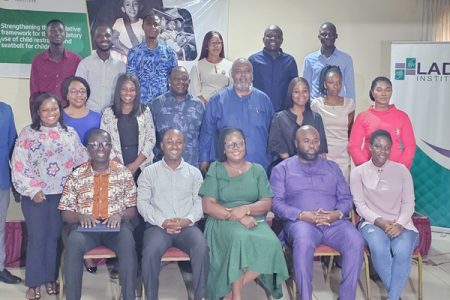The Lada Institute has renewed calls for urgent reforms to Ghana’s road safety laws to better protect child passengers, stressing the life-saving importance of child restraint systems in vehicles.
Speaking at a Media Awareness Workshop on Road Safety in Accra, the Institute’s Project Coordinator, Shirley Haizel-Ferguson, said the current Road Traffic Act and its regulations fail to adequately safeguard children.
She called for legislative amendments to address growing safety concerns.
“We’ve been working closely with the Ministry of Transport and a technical team to support amendments to the Road Traffic Act. Our goal is to ensure the law reflects international best practices on child restraint systems,” she stated.
The workshop, aimed at equipping journalists with the knowledge to influence public behavior through informed reporting, highlighted findings from a recent Lada Institute study that revealed key risk factors and safety gaps affecting child passengers in Ghana.
According to the research, a child sitting at the back seat of a vehicle without any restraint faces a 25% lower risk of injury in a crash compared to one sitting in front without a restraint.
However, both scenarios still pose a significant danger.
“Even though the back seat is relatively safer, no child should ride in a car without being properly restrained,
“Children using seatbelts alone are only partially protected—especially those between ages one and six. But children using the correct child restraint system reduce their risk of death by 60% and serious injury by 80%.” She stressed.
She also pointed out flaws in Ghana’s current law, which allows children under five years to sit in front seats if wearing seatbelts.
“This contradicts global safety advice. We recommend revising that age limit to at least 12 years. No child under that age should be in the front seat,” she said.
The Institute is also advocating for Ghana’s laws to reference safety standards from the Ghana Standards Authority, which is currently developing guidelines for appropriate child restraint systems based on age, height, and weight.
Shirley Haizel-Ferguson further urged the media to take an active role in public education.
“Child passenger safety is not just a legislative issue—it’s a public health priority. We need the media to lead advocacy efforts to save lives.” She noted.
Senior Manager at Vital Strategies, Samuel Boamah Danquah, also called for road infrastructure across Ghana’s cities to be deliberately designed with all categories of road users in mind—especially vulnerable groups such as pedestrians, cyclists, children, and the elderly.
He stressed that while Ghanaian cities are often referred to as “walking cities,” they are far from “walkable.”
According to him, vulnerable road users such as pedestrians and cyclists face the highest risk of injury or death in the event of a crash.
“All of us experience some level of risk the moment we step onto the road, but the extent varies depending on our mode of transport,” he explained.
Samuel Danquah also called attention to systemic gaps that make cities unsafe for pedestrians and cyclists, adding that “Most of our cities were built for cars, not people,”.
Citing examples from the U.S. and Ethiopia, Danquah illustrated how pedestrian-focused redesigns—such as better signage, upgraded line markings, and pedestrian-friendly intersections—have significantly improved safety. “The difference is commitment,” he said.
“In other countries, authorities return to evaluate and improve roads even after completion. Here, once a road is opened, that’s it.”
He urged government agencies, advocacy groups, and the general public to work together to champion safer urban mobility.
“We need infrastructure that works for everyone, not just those behind the wheel. Road safety isn’t a privilege; it’s a right,” he added.
The Media Awareness Workshop was organized as part of ongoing stakeholder engagements to support a national roadmap for improved road safety, particularly for vulnerable groups such as children.
By CHRISTABEL OBOSHIE ANNAN, Accra
- Friday, May 9, 2025 Newspaper Headlines - 9 May 2025
- Adangabey brightens rural kids’ future from his wheelchair - 9 May 2025
- Stanbic donates ICT equipment to UHAS for digital learning - 9 May 2025

